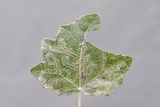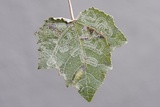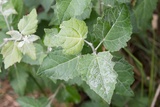Phyllocnistis xenia Hering, 1936 Species
Last modified: Dec. 10, 2025, 6:32 p.m.
A fairly common species in Belgium, with most observations in the northern part of the country, much rarer in the south.
Details
- Classification
- Family: Gracillariidae > Subfamily: Phyllocnistinae > Genus: Phyllocnistis > Species: Phyllocnistis xenia
- Vernacular names
- Printplaatmot (NL), Kent bent-wing (EN)
- Synonyms
- Phyllocnistis labyrinthella sensu auct., nec (Bjerkander, 1790)
- First mention in Belgium
- De Prins W. 1983a. Systematische naamlijst van de Belgische Lepidoptera. — Entomobrochure 4: 1–57. On page 10.
- Status
-
Native
Distribution
Imago
Head white; forewing ground colour silvery white, a little darker with yellowish hue in the apical area; five ochreous to brown costal striae of which the second one is prolonged to the dorsum, thus forming a narrow transversal band; a black spot in the apical area from which two dark brown hooks depart into the cilia, forming a horizontal "V". Not separable with certainty from the adult of P. labyrinthella.
Museum specimens
No pictures yet!Specimens in nature
No pictures yet!Caterpillar
Yellowish green with light brown head capsule.
Mine
A very long, winding corridor on the upper side of a leaf, never on the underside, and the mine never crosses itself. Sometimes, the mine occupies the entire leaf surface. The frass is concentrated in a continuous central, rather broad, and dark green frass, distinguishing it from the narrow, and almost black frass line in Phyllocnistis labyrinthella.
See also gracillariidae.net and bladmineerders.be.
Cocoon/pupa
No real cocoon, but a flimsy membrane; pupa yellowish brown.
Bionomics
The eggs are oviposited on the upper side of a leaf.
No real cocoon, but a flimsy membrane at the leaf margin; the leaf margin folds over the membrane. Pupation under the membrane.
The adults are active at dusk. The species hibernate in the adult stage.
Flight periods
The adults fly in two generations a year in July and again from late August–September, hibernating till May.
Observed on
- Host plant (species):
- Populus alba and Populus canescens
The species lives mainly on Populus alba, but it has also been recorded from Populus canescens.




